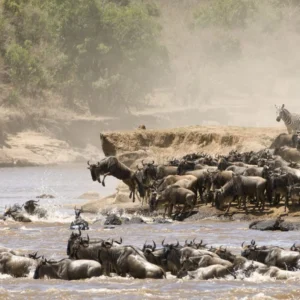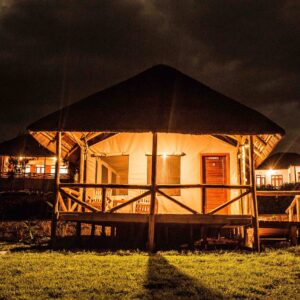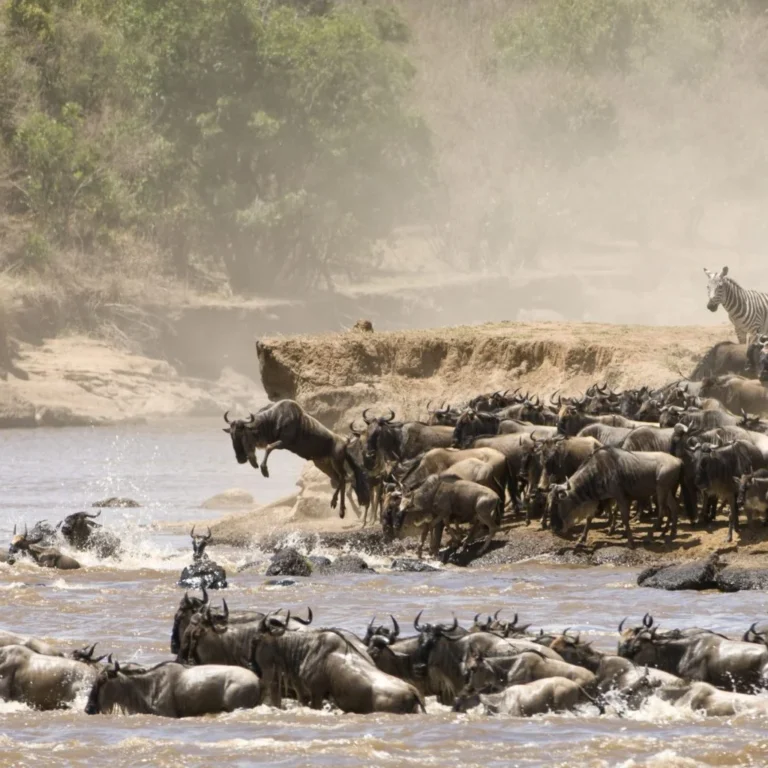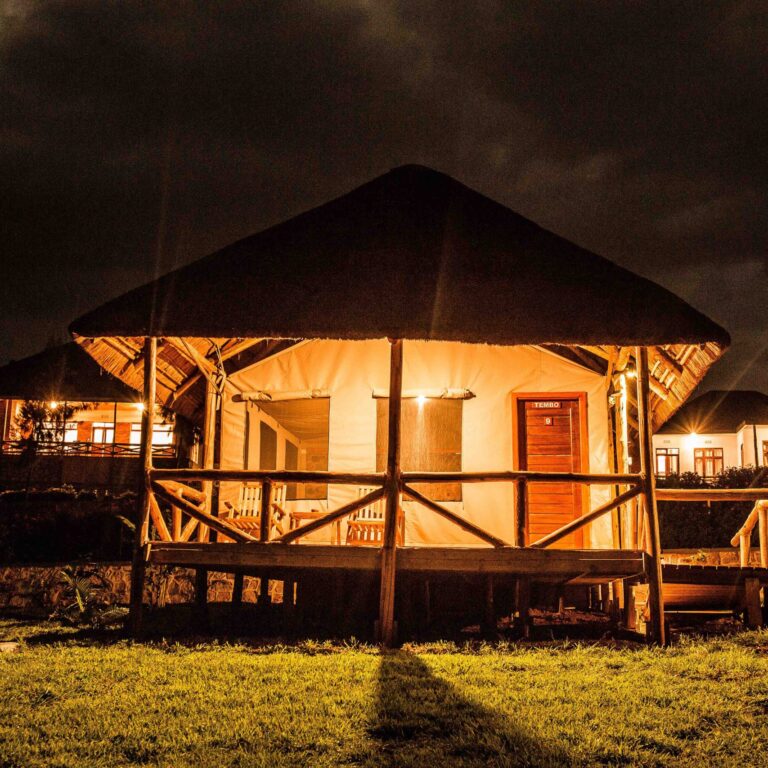Few wildlife spectacles on Earth rival the sheer scale, drama, and raw beauty of the Great Wildebeest Migration. This ceaseless, circular journey of millions of wildebeest, zebras, and gazelles across the vast plains of the Serengeti and Maasai Mara is a testament to nature’s enduring power and the relentless pursuit of survival. For anyone dreaming of an African safari, witnessing a part of this incredible odyssey is often at the very top of their bucket list. The Great Migration refers to the annual cycle of wildebeest, zebra, and other herbivores as they move across the Serengeti-Mara ecosystem in search of fresh grazing and water. This massive wildlife movement takes place between December and April in Tanzania’s Serengeti National Park.
But what exactly is the Great Migration? And how do you navigate its complex, ever-shifting patterns to be in the right place at the right time? This comprehensive guide will demystify this natural wonder, answering the crucial questions of “What,” “When,” and “Where” to help you plan your unforgettable journey. The Great Migration refers to the annual cyclical movement of over two million wildebeest, zebra, and other animals in the Serengeti-Mara ecosystem in East Africa. This massive migration, which is the largest terrestrial mammal migration on Earth, is driven by the search for fresh grazing and water following the rainy season, and it’s a mesmerizing spectacle that unfolds across the Serengeti National Park in Tanzania and the Maasai Mara National Reserve in Kenya.
What is The Great Migration?
At its heart, the Great Wildebeest Migration is the largest terrestrial mammal migration on the planet. It involves:
Over 1.5 million Wildebeest: These are the primary actors, driving the movement.
Hundreds of thousands of Zebras: They often follow the wildebeest, as their different grazing habits (zebras eat the taller, coarser grass, leaving the sweeter, shorter grass for wildebeest) create a synergistic relationship.
Tens of thousands of Thomson’s and Grant’s Gazelles, and Elands: These smaller antelopes also join parts of the journey.
The Driving Force: Rain and Grass
The migration is not a guided tour or a planned event. It is a primal, instinctive response to the annual rainfall patterns and the resulting availability of fresh, nutritious grazing pastures and water sources. The herds are constantly moving in a clockwise direction through the Serengeti-Mara ecosystem, driven by an innate urge to find sustenance.
The Circle of Life and Death:
This epic journey is a continuous cycle of life and death. Alongside the thundering hooves and the sheer numbers, there is constant drama:
Birth: Thousands of calves are born during the calving season.
Predation: The immense concentration of prey attracts a full cast of predators, including lions, leopards, cheetahs, and spotted hyenas, who follow the herds, capitalizing on the vulnerable, the weak, and the exhausted.
Obstacles: The herds must face perilous river crossings, where colossal Nile crocodiles lie in wait, and steep, dangerous riverbanks can cause injury or drowning.
It’s a “never-ending story,” as often described, covering an estimated 800 to 1,000 kilometers (500-600 miles) over a year, moving between Tanzania’s Serengeti National Park and Kenya’s Maasai Mara National Reserve.
When and Where: The Annual Cycle Unfolds (Month by Month)
The Great Migration is a year-round phenomenon, meaning there’s no single “best” time to see it, but rather specific times and locations to witness different phases of the cycle. Understanding this month-by-month breakdown is crucial for planning your safari.
1. December – March: The Calving Season & Southern Plains (Southern Serengeti / Ndutu Area, Tanzania)
Where: The migration typically begins its cycle on the short-grass plains of the Southern Serengeti, stretching into the Ndutu region of the Ngorongoro Conservation Area (though not into the Ngorongoro Crater itself).
What to Expect: This is the breeding and calving season, often peaking in February. Thousands of wildebeest calves are born daily (up to 8,000 per day in peak periods!). The plains are lush and green, providing abundant grazing.
Highlights: The undeniable cuteness of newborn calves taking their first wobbly steps. Intense predator action, as lions, cheetahs, and hyenas are drawn to the vulnerable young, leading to dramatic hunting spectacles.
Considerations: Great for photographers seeking action and tender moments. Less about movement, more about density and drama. The Great Migration in January, February, and March. Around January each year, the migration will be finishing a southward trek, moving along the eastern edge of the Serengeti and into the Ngorongoro Conservation Area.
2. April – May: The Long Rains & Herds on the Move (Central & Western Serengeti, Tanzania)
Where: As the short-grass plains of the south dry out, the herds begin their arduous northward and westward journey. They push through the central Seronera region and then funnel into the Western Corridor.
What to Expect: This period coincides with Tanzania’s long rains, so expect lush landscapes and potential afternoon showers. The herds form massive columns, sometimes stretching for kilometers, as they search for new pastures. May often marks the peak of the wildebeest rut (mating season), with fierce battles between male wildebeest vying for dominance.
Highlights: Witnessing the sheer scale of the moving columns. Dramatic skies during the rains. The raw display of male wildebeest competing.
Considerations: Roads can be muddy in April/early May, which can affect accessibility. Wildlife spotting might be harder due to thicker vegetation. Fewer tourists compared to the peak dry season.
3. June – July: The Grumeti River Crossings (Western Serengeti / Grumeti River, Tanzania)
Where: The migration reaches the Western Corridor of the Serengeti, facing its first major river obstacle: the Grumeti River.
What to Expect: This marks the beginning of the thrilling river crossings. While often smaller in scale than the later Mara River crossings, they are equally intense. Crocodiles lurk in the Grumeti’s waters, creating dramatic encounters. The timing is unpredictable, dependent on the river’s water levels.
Highlights: The tension and drama of the crossings. Crocodiles ambushing wildebeest. The spectacle of thousands of animals plunging into the water.
Considerations: The Western Corridor is a more remote part of the Serengeti, meaning fewer vehicles. Good for those seeking a less crowded crossing experience.
4. August – October: The Mara River Crossings (Northern Serengeti, Tanzania & Maasai Mara, Kenya)
Where: The herds continue their relentless march northward into the Northern Serengeti, encountering the formidable Mara River, which forms the border with Kenya’s Maasai Mara National Reserve.
What to Expect: This is widely considered the most iconic and dramatic phase of the migration, often dubbed “The World Cup of Wildlife.” Millions of animals gather at the riverbanks, sometimes for days, before making the perilous plunge into the crocodile-infested waters. The herds may cross back and forth multiple times between Tanzania and Kenya.
Highlights: The raw, powerful, and emotional scenes of the crossings. Close-up predator encounters (lions, leopards, cheetahs, hyenas) along the riverbanks. The sheer scale of hundreds of thousands of animals gathering.
Considerations: This is peak safari season, leading to higher prices and more vehicles around crossing points. Patience is crucial as crossings can be unpredictable.
5 November: The Short Rains & Return South (Central/Eastern Serengeti, Tanzania)
Where: As the short rains begin, the herds start their southward journey from the northern plains, moving through the central and eastern Serengeti, heading back towards the southern calving grounds.
What to Expect: The landscape transforms into a vibrant green after the rains. While less concentrated than the crossing periods, the herds can still be impressive, particularly in the eastern plains. This is a quieter period, with fewer crowds.
Highlights: Lush, green landscapes and dramatic skies. Fewer tourists. Still good general game viewing.
Considerations: Migration movements can be more dispersed and challenging to predict accurately during this transition month.
General Considerations for Timing:
Flexibility is Key: The exact timing and location of the herds depend on rainfall patterns, which can vary year to year. A flexible itinerary and an experienced safari guide are crucial.
Mobile Camps: For the best chance of being “with the migration,” consider staying in mobile tented camps that move seasonally to follow the herds.
Beyond the Main Events: Even outside of the calving or river crossing peak times, the Serengeti ecosystem offers phenomenal resident game viewing year-round.
Why Does the Migration Happen? The Ecological Dance
The Great Migration is not a random walk; it’s a precisely tuned ecological phenomenon driven by:
Rainfall Patterns: The herds are constantly chasing fresh grass and water, which grow in response to seasonal rainfall across the vast Serengeti-Mara ecosystem. Their instincts guide them towards areas that have recently received rain.
Nutrient-Rich Grasses: The short-grass plains of the southern Serengeti, for instance, are particularly rich in minerals due to ancient volcanic ash deposits, making them ideal for birthing and nursing calves during the wet season.
Predator-Prey Dynamics: The abundance of prey ensures a healthy population of predators, who in turn keep the wildebeest herds strong by culling the weak. This creates a self-sustaining ecosystem.
Resource Management: By constantly moving, the herds prevent overgrazing in any single area, allowing the ecosystem to regenerate.
What to Expect on a Migration Safari
Vastness: Prepare for immense, sweeping landscapes. The Serengeti truly feels like “the land that runs on forever.”
Thundering Hooves: The sheer sound of thousands of hooves is unforgettable.
Dust & Drama: Especially during dry seasons and crossings, dust clouds are a constant feature.
Predator Action: The migration is a feast for predators. You’ll likely witness intense predator-prey interactions.
Early Mornings & Late Evenings: Game drives typically start early to catch animals at their most active and conclude in the late afternoon.
Patience: Finding the herds and witnessing specific events (like a crossing) requires patience. Your guide will be in constant communication with other guides to track movements.
Luxury & Comfort: Even mobile tented camps offer surprising levels of luxury, with comfortable beds, en-suite bathrooms, and gourmet meals.
When to see the Great Migration in Tanzania? The herds head towards the north of the Serengeti. The river crossings, considered by some to be the most exciting events of the Great Migration, usually start in July, but timing all depends on the rains. The herds can generally be seen in the Masai Mara and far north of the Serengeti between July and October, after which they head south through the east central Serengeti before arriving in the southern plains around December. The migration herds remain settled here around Ndutu until March.
Where does the wildebeest migration start and end? Because the Great Migration is a fluid, year-round movement of about two million animals across the Serengeti-Mara ecosystem, there are no defined start or end points. The Gnu Migration is triggered by East Africa’s rains and the animals follow an age-old route in search of fresh grazing and water.
What is the Great Migration in Tanzania’s Serengeti? The initial phase lasts from about January to March, when the calving season begins – a time when there is plenty of rain-ripened grass available for the 260,000 zebras that precede 1.7 million wildebeest and the following hundreds of thousands of other plains game, including around 470,000 gazelles. The Great Migration is a spectacle unlike any other on earth. Around two million animals move en masse across the landscape of the Serengeti and Maasai Mara. The bulk of the migrating mammals are wildebeests. But there are also incredible numbers of zebras and different antelopes taking part too.
How far do wildebeest travel during migration? Guided by survival instinct, each wildebeest will cover 800 to 1,000km on its individual journey along age-old migration routes. Hungry predators, including lion, leopard, cheetah, hyena, wild dog, and crocs, make sure only the strongest survive in this natural spectacle also known as ‘the greatest show on Earth
Where is the best place to see the Great Migration? The Kogatende area in the northern Serengeti is a great place to catch the migration, between July and October, but with July and August typically the the Great Wildebeest Migration peak months. There is a permanent pride of lions in the area that you can see year-round, along with other leopards and cheetahs.
- When To Go On Your Great Migration Safari
- Tips for Planning Your Wildebeest Migration Safari
- 10 Interesting Facts About the Great Wildebeest Migration
- 8 Day Great Wildebeest Migration | The Great Migration Highlights – Luxury Safari
- Complete Guide to a Wildebeest Migration Safari
Conclusion: A Journey into the Wild Heart of Africa
The Great Wildebeest Migration is more than just a trip; it’s a profound immersion into the raw, untamed heart of Africa. It’s a journey that transcends typical wildlife viewing, offering an unparalleled spectacle of life, death, and perseverance. By understanding the “What, When, and Where” of this incredible phenomenon, you can meticulously plan your safari, ensuring you are perfectly positioned to witness the awe-inspiring drama unfold before your very eyes. It’s an adventure that will forever redefine your connection to the natural world.






